Drawing Title Block |
  
|
The drawing title block module is an application that is launched automatically upon launching the T-FLEX CAD. If necessary it can be launched manually from the Applications command.
Adding Title Block to Drawing Page
Icon |
Ribbon |
|---|---|
|
Title Block > Title Block > New |
Keyboard |
Textual Menu |
|
Title Block > Title Block > New |
To create a title block, this command is intended.
After calling the command, you need to select the type of the title block from the list.
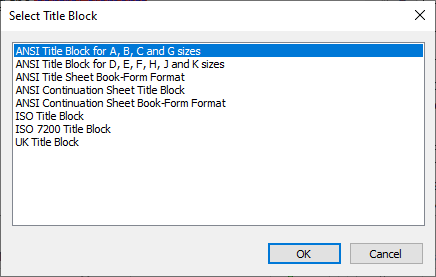
You can add to this list yourself by creating the title block necessary for drawing design, and adding them to the list using the Options command. After selecting the type, a window will appear on the screen to fill in the title block. This window is a dialog for editing the values of the external variables of the fragment and by default displays the dialog created in the document of the main label using the control elements.
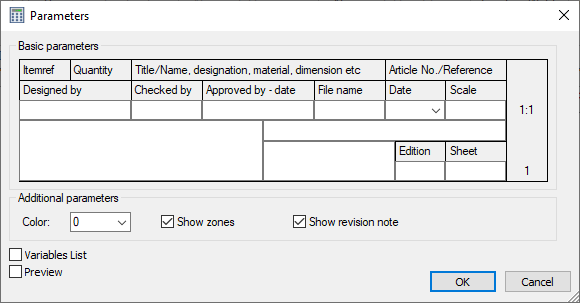
The Variables list flag displays this window as an external variable editor.
It should be noted that the format fields Drawing Number and Title display the values of hidden variables, which are also associated with the data for the specification of the current document. Therefore, when entering data into these formatting fields, the corresponding data for the specification is automatically filled in.
Editing Contents of Title Block
To edit the contents of the title block fields, use the command:
Icon |
Ribbon |
|---|---|
|
Title Block > Title Block > Edit |
Keyboard |
Textual Menu |
- |
Title Block > Title Block > Edit |
To re-select a type of a title block, use the command:
Icon |
Ribbon |
|---|---|
|
Title Block > Title Block > Change Type |
Keyboard |
Textual Menu |
- |
Title Block > Title Block > Change Type |
To modify the title block's position, use the command:
Icon |
Ribbon |
|---|---|
|
Title Block > Title Block > Move > Move Title Block |
Keyboard |
Textual Menu |
- |
Title Block > Title Block > Move |
The command allows you to change the position of the title block (after the call, a dynamically moving image of the title block appears on the screen). Point the cursor at the necessary point in the 2D window and click ![]() - the title block will be moved to the new position.
- the title block will be moved to the new position.
You can change the title block type and move the title block by selecting the respective item in the context menu, which appears on right-clicking ![]() the title block fragment.
the title block fragment.
The title block can also be filled directly in the drawing. To do that, place the text cursor in the title block field, which needs to be filled, and click ![]() . A blinking cursor will appear in the selected field, indicating the readiness to input text, and a button with an arrow will appear next to the selected field, serving to select a value from the list. Initially, the list is empty (except for the fields in the "Date" column). If you need to fill in the list in order to have list values available in the future, then in the selected field enter the necessary text, and then select the Add to List item in the context menu.
. A blinking cursor will appear in the selected field, indicating the readiness to input text, and a button with an arrow will appear next to the selected field, serving to select a value from the list. Initially, the list is empty (except for the fields in the "Date" column). If you need to fill in the list in order to have list values available in the future, then in the selected field enter the necessary text, and then select the Add to List item in the context menu.
Since the title block is a drawing fragment, there is another way to apply it - by using the command Create Fragment. If you want to use one of the standard title blocks, then when selecting the fragment file, specify the required document in the System\Titleblk library. After that, the dialog described above for editing the external variables of the fragment will appear.
Note that when inserting several title blocks into the current document (for example, for drawings located on different pages), the data from all title blocks will be bound to the same variables of the current document. As a result, the contents of the fields Drawing Number and Title of all title blocks will be same. As you edit fields in one title block, the text will be changing in all the rest of them. To disable this mode, you need to cancel the established relation with the hidden drawing variables, and then define the new field value. To do this, you need, regardless of the variable editing technique, call the context menu for the respective field. In the menu, clear the check in the Insert Variable item. After that, you can edit the text value in the current field. To relate this field with a new variable, call the same command again and define the name of the new variable in the upcoming Insert Variable window.
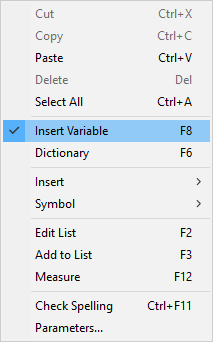
When editing the title block using the dialog for editing fragment external variables, you have another alternative. If you enable the Variables List flag in this dialog, then, instead of a dialog with interface control elements you'll see the standard list of the format frame fragment external variables. Find the $Drawing_Number and $TITLE variables in it (the fields Drawing number and Title), and replace their values with constants.
In some cases, you may need to suppress automatic binding of title blocks variables with the variables of the current drawing. This may be needed, for example, when frequently creating documents containing several different drawings. In such a case, it is more convenient to edit the title blocks document itself, to have the automatic variable bindings suppressed on inserting it into the current document. To do this, open the format frame document, go into the variables editor and delete the contents of the Assembly Variable Name parameter from the above-listed variables.
Title Block Fitting
The commands below serve to define the size of the format of the drawing, and therefore the title block.
Icon |
Ribbon |
|---|---|
|
Title Block > Title Block > Move > Standard |
Keyboard |
Textual Menu |
|
Title Block > Fit Title Block Size > Standard |
The command picks the format of the closest standard size.
Icon |
Ribbon |
|---|---|
|
Title Block > Title Block > Move > By Drawing Limits |
Keyboard |
Textual Menu |
|
Title Block > Fit Title Block Size > By Drawing Limits |
In this case, the format size and position are adjusted so that they fit all graphic lines and drawing detailing elements existing on a current page. Automatically calculated width and height of the format are put into Document Parameters (Document Parameters > Page > Paper > Paper Size > Format > Custom).
Icon |
Ribbon |
|---|---|
|
Title Block > Title Block > Move > By Current Window |
Keyboard |
Textual Menu |
|
Title Block > Fit Title Block Size > By Current Window |
In this case, the format size and position are defined by the current size of the 2D window. Automatically calculated width and height of the format are put into Document Parameters (Document Parameters > Page > Paper > Paper Size > Format > Custom).
Updating Title Block
See the Update Layout Elements section.
Icon |
Ribbon |
|---|---|
|
Title Block > Options > Options |
Keyboard |
Textual Menu |
|
Title Block > Options |
After calling this command, a dialog window appears on the screen with two tabs.
Title Blocks
This tab contains the list of title block types used for layouts. You can edit this list using the buttons Edit, Add, Delete. The first two buttons call the same dialog window, only in the first case it is used for an existing type, and in the second - for a new one.
These two buttons call the dialog, where you have to specify:
•Title
The title block name, which will be entered in the list of title block types.
•File name
The name to the title block file.
Title Block Parameters
Sets the values of the fields of the title block. If the Set as Default flag is set, these values will be substituted by default in the corresponding fields of the title block of the drawing.
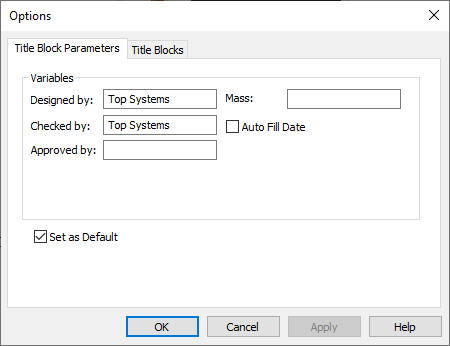
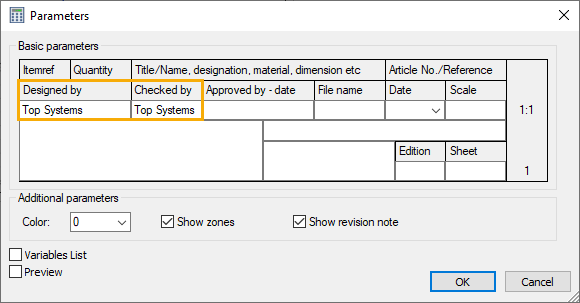
If you have changed the type of the title block of the drawing, the system will offer to transfer the text of the drawing notes in accordance with the changed size or position of the title block.